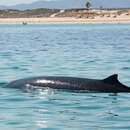pms
nòm ant ël fil


Little is known about M. peruvianus due to its inaccessible habitat and elusive nature.
Mesoplodon peruvianus has several common names. Among them are Lesser Beaked Whale, Peruvian Beaked Whale and Pygmy Beaked Whale (The Whale and Dolphin Conservation Society, Cetacea and Texas A&M University - Corpus Christi, 2001).
Texas A&M University - Corpus Christi reports that M. peruvianus can most easily be mistaken for Hector's beaked whale (Texas A&M University - Corpus Christi, 2001).
Perception Channels: tactile ; chemical
IUCN Red List of Threatened Species: data deficient
Although feeding by M. peruvianus has not been witnessed, it is believed that this species eats mid- to deep-sea fish and squid (Cetacea, 2001).
Animal Foods: fish; mollusks
Primary Diet: carnivore (Piscivore , Molluscivore )
Mesoplodon peruvianus was discovered in Peru in 1991 and is only known in Peruvian waters, although there have been two documented strandings on Mexican shores (The Whale and Dolphin Conservation Society, 2001). Strandings and captures have taken place between 11 and 15 degrees south latitude, off the coast of central and southern Peru. This is thought to be the southern end of the range of M. peruvianus (Texas A&M University - Corpus Christi, 2001).
Biogeographic Regions: neotropical (Native ); pacific ocean (Native )
This species lives in mid- to deep-sea waters off of the Peruvian coast.
Habitat Regions: tropical ; saltwater or marine
Aquatic Biomes: pelagic
At birth, M. peruvianus is between 1.5-1.6 m long, while the adult is between 3.4-3.7 m. This whale is the smallest species of Mesoplodon (World Biodiversity Database, 2001). This species is, on its upper side, uniformly dark gray fading to light gray on the underside (dark gray posterior to the navel). The body is spindle-shaped. The short, dark-tipped beak precedes a narrow head with an indentation at the blowhole. This species has two tiny teeth on its lower jaw. The small, triangular dorsal fin has a wide base and is positioned far behind the center of the animal. The flukes have no notches, and their tips are slightly pointed. (All information from Texas A&M University - Corpus Christi, 2001 unless otherwise noted.)
M. peruvianus exhibits sexual dimorphism. The males of the species are larger than the females (World Biodiversity Database, 2001).
The features that distinguish this Mesoplodon species from others of its genus are most prominent in males (Webb, 1998).
Range length: 3.4 to 3.7 m.
Other Physical Features: endothermic ; bilateral symmetry
Humans are the only known threat to M. peruvianus. This whale becomes tangled in fishing nets, which initially led to the discovery of this species.
Key Reproductive Features: gonochoric/gonochoristic/dioecious (sexes separate); sexual